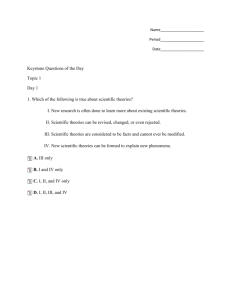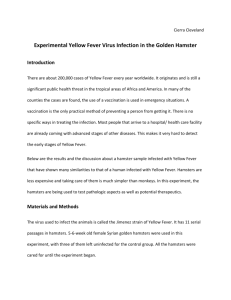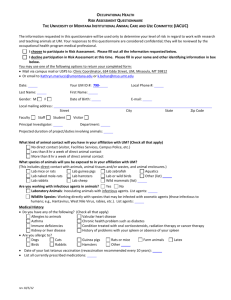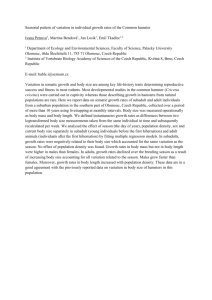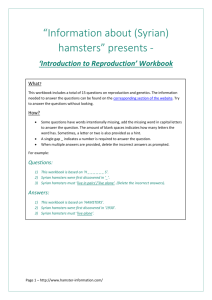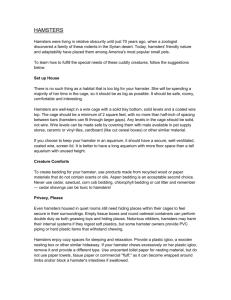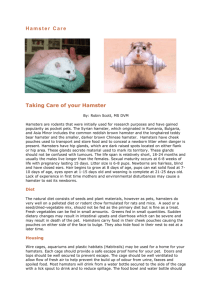F1B Literature - Bio Breeders Inc
advertisement
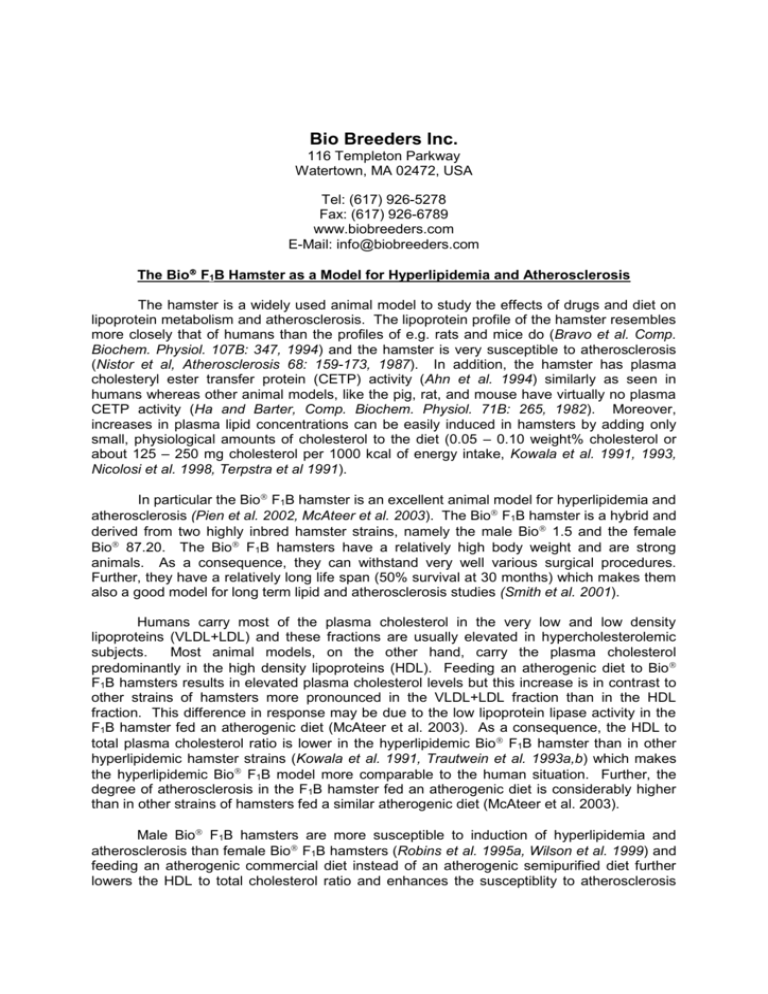
Bio Breeders Inc. 116 Templeton Parkway Watertown, MA 02472, USA Tel: (617) 926-5278 Fax: (617) 926-6789 www.biobreeders.com E-Mail: info@biobreeders.com The Bio F1B Hamster as a Model for Hyperlipidemia and Atherosclerosis The hamster is a widely used animal model to study the effects of drugs and diet on lipoprotein metabolism and atherosclerosis. The lipoprotein profile of the hamster resembles more closely that of humans than the profiles of e.g. rats and mice do (Bravo et al. Comp. Biochem. Physiol. 107B: 347, 1994) and the hamster is very susceptible to atherosclerosis (Nistor et al, Atherosclerosis 68: 159-173, 1987). In addition, the hamster has plasma cholesteryl ester transfer protein (CETP) activity (Ahn et al. 1994) similarly as seen in humans whereas other animal models, like the pig, rat, and mouse have virtually no plasma CETP activity (Ha and Barter, Comp. Biochem. Physiol. 71B: 265, 1982). Moreover, increases in plasma lipid concentrations can be easily induced in hamsters by adding only small, physiological amounts of cholesterol to the diet (0.05 – 0.10 weight% cholesterol or about 125 – 250 mg cholesterol per 1000 kcal of energy intake, Kowala et al. 1991, 1993, Nicolosi et al. 1998, Terpstra et al 1991). In particular the Bio F1B hamster is an excellent animal model for hyperlipidemia and atherosclerosis (Pien et al. 2002, McAteer et al. 2003). The Bio F1B hamster is a hybrid and derived from two highly inbred hamster strains, namely the male Bio 1.5 and the female Bio 87.20. The Bio F1B hamsters have a relatively high body weight and are strong animals. As a consequence, they can withstand very well various surgical procedures. Further, they have a relatively long life span (50% survival at 30 months) which makes them also a good model for long term lipid and atherosclerosis studies (Smith et al. 2001). Humans carry most of the plasma cholesterol in the very low and low density lipoproteins (VLDL+LDL) and these fractions are usually elevated in hypercholesterolemic subjects. Most animal models, on the other hand, carry the plasma cholesterol predominantly in the high density lipoproteins (HDL). Feeding an atherogenic diet to Bio F1B hamsters results in elevated plasma cholesterol levels but this increase is in contrast to other strains of hamsters more pronounced in the VLDL+LDL fraction than in the HDL fraction. This difference in response may be due to the low lipoprotein lipase activity in the F1B hamster fed an atherogenic diet (McAteer et al. 2003). As a consequence, the HDL to total plasma cholesterol ratio is lower in the hyperlipidemic Bio F1B hamster than in other hyperlipidemic hamster strains (Kowala et al. 1991, Trautwein et al. 1993a,b) which makes the hyperlipidemic Bio F1B model more comparable to the human situation. Further, the degree of atherosclerosis in the F1B hamster fed an atherogenic diet is considerably higher than in other strains of hamsters fed a similar atherogenic diet (McAteer et al. 2003). Male Bio F1B hamsters are more susceptible to induction of hyperlipidemia and atherosclerosis than female Bio F1B hamsters (Robins et al. 1995a, Wilson et al. 1999) and feeding an atherogenic commercial diet instead of an atherogenic semipurified diet further lowers the HDL to total cholesterol ratio and enhances the susceptiblity to atherosclerosis The Bio F1B Hamster as a Model for Hyperlipidemia and Atherosclerosis Bio Breeders Inc., Watertown MA 02472, USA (Kowala 1991, Nicolosi et al. 1998). Further, groupswise housing of Bio F1B hamsters has been shown to result in higher lipid levels and a higher degree of atherosclerosis than when the hamsters are housed individually (Smith et al. 1997, Yoganathan et al. 1998). Hamster HDL lipoproteins can be easily isolated by precipitation of the VLDL+LDL with phosphotungstic acid/MgCl2 (Weingand and Daggy, Clin. Chem. 36, 575, 1990, Kowala et al, 1991) and HDL cholesterol levels in Bio F1B hamsters measured with this precipitation method are identical to those obtained by the ultracentrifugation method (Kowala 1991). A complete separation of all the lipoprotein fractions, i.e. HDL, LDL, and VLDL, can be done by ultracentrifugation and these lipoprotein fractions in hamsters have density limits similar to those in humans (Kowala et al. 1991). Literature Cholesterol Metabolism and Atherosclerosis Studies in Bio F1B Hamsters Alexa, A., Wilson, T.A., Atallah, M.T., Handelman, G. & Nicolosi, R.J. (2004) Hamsters fed diets high in saturated fat have increased cholesterol accumulation and cytokine production in the aortic arch compared with cholesterol-fed hamsters with moderately elevated plasma non-HDL cholesterol concentrations. J. Nutr. 134: 410-425. (PDF) Ahn, Y.-S., Smith, D. E., Osada, J., Li, Z., Schaefer, R.J. & Ordovas, J.M. (1994) Dietary fat saturation affects apolipoprotein gene expresssion and high denstity lipoprotein size distribution in golden syrian hamsters. J. Nutr. 124: 2147-2155. F1B hamsters have plasma cholesteryl ester transfer protein (CETP) activity like humans. Ausman, L.M., Rong, N. & Nicolosi, R.J. (2005) Hypocholesterolemic effect of physically refined rice bran oil: Studies of cholesterol metabolism and early atherosclerosis in hypercholesterolemic hamster, J. Nutr. Biochem. 16: 521-529. (PDF) Blair, R.M., Aptt, S.E., Bennetau-Pelissero, C., Clarkson, T.B., Anthony, M.S., Lamothe, V. & Potter, S.M. (2002) Dietary soy and soy isoflavones have gender-specific effects on plasma lipids and isoflavones in Golden Syrian F1B hybrid hamsters. J. Nutr. 132: 3585-3591. (PDF) Carr, T.P., Weller, C.L., Schlegel, V.L., Cuppett, S.L., Guderian, D.M. & Johnson, K.R. (2005) Grain sorghum lipid extract reduces cholesterol absorption and plasma nonHDL cholesterol conventration in hamsters, J. Nutr. 135: 2236-2240. (PDF) De Deckere, E.A.M., de Fouw, N.J., Ritskes-Hoitinga, J., van Nielen, W.G.L. & Blonk, C.G. (1993) Effect of an atherogenic diet on lipoprotein cholesterol profile in the F1B hybrid hamster. Atherosclerosis 103: 291-294. DeDeckere, E.A.M., Van Amelsfoort, J.M.M., McNeill, G.P. & Jones, P. (1999). Effects of conjugated linoleic acid (CLA) isomers on lipid levels and peroxisome proliferation in the hamster. Br. J. Nutr. 82: 309-317. (PDF) Delaney, B., Nicolosi, R.J., Wilson, T.A., Carlson, T., Frazer, S., Zheng, G.-H., Hess, R., Ostergren, K., Haworth, J. & Knutson, N. (2003) ß-Glucan fractions from barley and oats are similarly antiatherogenic in hypercholesterolemic syrian golden hamsters. J. Nutr. 133: 468-495. (PDF) 2 The Bio F1B Hamster as a Model for Hyperlipidemia and Atherosclerosis Bio Breeders Inc., Watertown MA 02472, USA DeSilva, P.P., Davis, P.J. & Cheema, S.K. (2004) Hyperlipidaemic effect of fish oil in Bio F 1B hamster. Br. J. Nutr. 91: 341-349. (PDF) Dorfman, S.E., Smith, D.E., Osgood, D.P. & Lichtenstein, A.H. (2003) Study of diet induced changes in lipoprotein metabolism in two strains of golden syrian hamsters. J. Nutr. 133: 4183-4188. (PDF) El-Swefy, S., Schaefer, E.J., Seman, L.J., van Dongen, D., Sevanian, A., Smith, D.E., Ordovas, J.M., El-Sweidy, M. & Meydani, M. (2000) The effect of vitamin E, probucol, and lovastatin on oxidative status and aortic fatty lesions in hyperlipidemic-diabetic hamsters. Atherosclerosis 149: 277-286. (PDF) Faia, K.L , Davis, W.P., Marone, A.J., & Foxall, T.L. (2002) Matrix metalloproteinases and tissue inhibitors of metalloproteinases in hamster aortic atherosclerosis: Correlation with in-situ zymography. Atherosclerosis 160: 325-337. (PDF) Foxall, T.L., Shwaery, G.T., Stucchi, A.F., Nicolosi, R.J. & Wong, S.S. (1992) Dose-related effects of doxazosin on plasma lipids and aortic fatty streak formation in the hypercholesterolemic hamster model. Am. J. Pathol. 140: 1357-1363. Kowala, M. C. & Nicolosi, R. J. (1989) Effect of doxazosin on plasma lipids and atherogenesis: a preliminary report. J. Cardiovasc. Pharmacol. 13 Suppl 2: S45-49. Kowala, M.C., Nunnari, J.J., Durham, S.K. & Nicolosi, R.J. (1991) Doxazosin and cholestyramine similarly decrease fatty streak formation in the aortic arch of hyperlipidemic hamsters. Atherosclerosis 91: 35-49. (PDF) Kowala, M.C. (1993) Effects of an atherogenic diet on lipoprotein cholesterol profile in the F1B hybrid hamster. Atherosclerosis 103: 293--294. F1B hamsters fed a cholesterol-enriched semipurified diet have a higher HDL to total cholesterol ratio than F1B hamsters fed a cholesterol-enriched chow diet. Kowala, M. C., Mazzucco, C. E., Hartl, K. S., Seiler, S. M., Warr, G. A., Abid, S., & Grove, R. I. (1993) Prostacyclin agonists reduce early atherosclerosis in hyperlipidemic hamsters. Octimibate and BMY 42393 suppress monocyte chemotaxis, macrophage cholesteryl ester accumulation, scavenger receptor activity, and tumor necrosis factor production. Arterioscler. Thromb. 13: 435-444. (PDF) Kowala, M. C., Grove, R. I., & Aberg, G. (1994) Inhibitors of angiotensin converting enzyme decrease early atherosclerosis in hyperlipidemic hamsters. Fosinopril reduces plasma cholesterol and captopril inhibits macrophage-foam cell accumulation independently of blood pressure and plasma lipids. Atherosclerosis 108: 61-72. (PDF) Kowala, M. C., Reece, R., Beyer, S., & Aberg, G. (1995) Regression of early atherosclerosis in hyperlipidemic hamsters induced by fosinopril and captopril. J. Cardiovasc. Pharmacol. 25: 179-186. Kowala, M. C., Rose, P. M., Stein, P. D., Goller, N., Recce, R., Beyer, S., Valentine, M., Barton, D., & Durham, S. K. (1995) Selective blockade of the endothelin subtype A receptor decreases early atherosclerosis in hamsters fed cholesterol. Am. J. Pathol. 146: 819-826. 3 The Bio F1B Hamster as a Model for Hyperlipidemia and Atherosclerosis Bio Breeders Inc., Watertown MA 02472, USA Lee, J.-Y. & Carr, T.P. (2004) Dietary fatty acids regulate acyl-CoA:cholesterol acyltransferase and cytosolic cholesteryl ester hydrolase in hamsters. J. Nutr. 134: 3239-3244. (PDF) Lee, J.-Y. & Carr, T.P. (2005) Dietary fatty acids regulate the expression of ABCG5 and ABCG8 in hamsters. Nutrition Research 11: 167-175. (PDF) McAteer, M.A., Grimsditch, D.C., Vidgeon-Hart, M., Benson, G.M. & Salter, A.M. (2003) Dietary cholesterol reduces lipoprotein lipase activity in the atherosclerosissusceptible Bio F1B hamster. Br. J. Nutr. 89: 341-350. (PDF) Meijer, G.W., van Tol, A, van Berkel, Th.J.C. & Westrate, J.A. (2001) Effect of dietary elaidic versus vaccenic acid on blood and liver lipids in the hamster. Atherosclerosis 157: 31-40. (PDF) Nicolosi, R.J., Rogers, E.J., Kritchevsky, D., Scimeca, J.A. & Huth, P.J. (1997) Dietary conjugated linoleic acid reduces plasma lipoproteins and early aortic atherosclerosis in hypercholesterolemic hamsters. Artery 22: 266-277. Nicolosi, R.J., Wilson, T.A., Lawton, C., Rogers, E.J., Wiseman, S.A., Tijburg, L.B.M. & Kritchevsky, D. (1998) The greater atherogenecity of nonpurified diets versus semipurified diets in hamsters is mediated via differences in plasma lipoprotein cholesterol distribution, LDL oxidative susceptibility, and plasma -tocopherol concentration. J. Nutr. Biochem. 9: 591-597. (PDF) F1B hamsters fed a cholesterol-enriched semipurified diet have a higher HDL to total cholesterol ratio and are more susceptible to atherosclerosis than F1B hamsters fed a cholesterol-enriched chow diet. Nicolosi, R.J., Wilson, T.A., & Krause, B.R. (1998) The ACAT inhibitor, CI-1011 is effective in the prevention and regression of aortic fatty streak area in hamsters. Atherosclerosis 137: 77-85. (PDF) Nicolosi, R.J., Lawton, C.W. & Wilson, T.A. (1999) Vitamin E reduces plasma low density lipoprotein cholesterol, LDL oxidation, and early aortic atherosclerosis compared with black tea in hypercholesterolemic hamsters. Nutrition Research 19: 1201-1214. (PDF) Otto, J., Smith, D., van Dongen, D., Nicolosi, R.J. & Schaefer, E.J. (1995) Lovastatin inhibits diet induced athersclerosis in F1B golden syrian hamster. Atherosclerosis 114: 19-28. (PDF) Pien, C.S. (1995) Cellular and molecular characterization of hamster aortic athersclerosis. M.S. Thesis, University of New Hampshire. Pien, C.S., Davis, W.P., Marone, A.J. & Foxall, T.L. (2002) Characterization of diet induced aortic atherosclerosis in Syrian F1B hamsters. J. Exp. Anim. Sci. 42: 65-83. Pitman,W.A., Osgood, D.P., Smith, D., Schaefer, E.J. & Ordovas, J.M. (1998) The effects of diet and lovastatin on regression of fatty streak lesions and on hepatic mRNA levels for the LDL receptor and HMG CoA reductase in F1B hamsters. Atherosclerosis 138: 43-52. (PDF) 4 The Bio F1B Hamster as a Model for Hyperlipidemia and Atherosclerosis Bio Breeders Inc., Watertown MA 02472, USA Robins, S.J., Fasulo, J.M., Patton, G.M., Schaefer, E.J., Smith, D.E. & Ordovas, J.E. (1995a) Gender differences in the development of hyperlipemia and atherosclerosis in hybrid hamsters. Metabolism 44: 1326-1331. (PDF) Male F1B hamsters fed a cholesterol-enriched semipurified diet are more susceptible to hypercholesterolemia and atherosclerosis than female F1B hamsters. Robins, S.J., Fasulo, Pritzker, C.R., Ordovas, J.M. & Patton, G.M. (1995b) Diurnal changes and adaptation by the liver of hamsters to an atherogenic diet. Am. J. Physiol. 269: R1327-1332). (PDF) Rong, N., Ausman. & Nicolosi, R.J. (1997) Oryzanol decreases cholesterol absorption and aortic fatty streaks in hamsters. Lipids 32: 303-309. Smith, D.E., Schaefer, E.J. & Ordovas, J.M. (1995) The effects of fasting on plasma lipids in an animal model for the study of diet-induced atherosclerosis (the F1B Golden Syrian Hamster). Canadian Assoc. Lab. Animal Sci. 30: 78-79. Smith, D. E., Pedro-Botet, J., Cantuti-Castelvetri, I., Schaefer, E.J. & Ordovas, J.M. (1997) Influence of age, diet, and laboratory caging on lipid profile among F1B hamsters. Nutr. Res. 17: 1569-1575. (PDF) F1B hamsters housed in groups have higher plasma lipid levels and degree of atherosclerosis than F1B hamsters housed individually. Smith, D. E., Espino-Montoro, A., Perez-Jimenez, F., Pedro-Botet, J., Jimenez Perperez, J. & Ordovas, J.M. (2000) Effect of a high saturated fat and cholesterol diet supplemented with squalene or β-sitosterol on lipoprotein profile in F1B hamsters. Nutr. Res. 20: 1309-1318. (PDF) Smith, D.E., Pedro-Botet, J., Cantuti-Castelveti, J., Shukitt-Hale, B., Schaefer, E.J. & Ordovas, J.M. (2001) Influence of photoperiod, laboratory caging and aging on plasma lipid response and atherogenic diet among F1B hamsters. Int. J. Neurosci. 106: 185-194. Spady, D.K. & Dietschy, J.M. (1989) Interaction of aging and dietary fat in the regulation of low density lipoprotein transport in the hamster. J. Lipid Res. 30: 559-569. (PDF) Terpstra, A.H.M., Holmes, J.C. & Nicolosi, R.J. (1991) The hypocholesterolemic effect of dietary soybean protein vs casein in hamsters fed cholesterol-free or cholesterolenriched semipurified diets. J. Nutr. 121: 944-947. Terpstra, A.H.M., Laitinen, L.L., Stucchi, A.F. & Nicolosi, R.J. (1994) The effect of semipurified diets containing two levels (20% and 40%) of either casein or soybean protein isolate and concentrate on plasma lipids in hamsters. Nutr. Res. 14: 885-895. Terpstra, A.H.M., Lapré, J.A., de Vries, H.T. & Beynen, A.C. (2002) The smooth or polygalacturonic acid regions of pectin have similar hypocholesterolemic properties in hybrid F1B hamsters as the intact pectin. Nahrung-Food 46: 83-86. (PDF) Terpstra AHM, Lapré JA, de Vries HT, Beynen A.C. (2002) The cholesterol lowering effect of lemon peels, lemon pectin, and the waste stream of lemon peels in hybrid F 1B hamsters. Eur. J. Nutr. 41: 19-26. (PDF) 5 The Bio F1B Hamster as a Model for Hyperlipidemia and Atherosclerosis Bio Breeders Inc., Watertown MA 02472, USA Trautwein, E.A, Liang, J. & Hayes, K.C. (1993a) Plasma lipoproteins, biliary lipids and bile acid profile differ in various strains of Syrian hamsters, mesocritus auratus. Comp. Biochem. Physiol. 104A: 829-835. (PDF) F1B hamsters fed a cholesterol-free semipurified diet have cholesterol ratio than other strains of hamsters. a lower HDL : total plasma Trautwein, E.A, Liang, J. & Hayes, K.C. (1993b) Cholesterol gallstone induction in hamsters reflects strain differences in plasma lipoproteins and bile acid profiles. Lipids 28: 305312. F1B hamsters fed a cholesterol-enriched semipurified diet have a lower HDL : total plasma cholesterol ratio than other strains of hamsters. Wilson, T. A., Meservey, C. M., & Nicolosi, R. J. (1998) Soy lecithin reduces plasma lipoprotein cholesterol and early atherogenesis in hypercholesterolemic monkeys and hamsters: beyond linoleate. Atherosclerosis 140: 147-153. (PDF) Wilson, T.A., Romano, C., Liang, J. & Nicolosi, R.J. (1998) The hypocholesterolemic and anti atherogenic effects of cholazol H, a chemically functionalized insoluble fiber with bile acid sequestrant properties in hamsters. Metabolism 47: 959-964. (PDF) Wilson, J., Nicolosi, R.J., Lawton, C.W. & Babiak, J. (1999) Gender differences in response to a hypercholesterolemic diet in hamsters: effects on plasma lipoprotein cholesterol concentrations and early aortic atherosclerosis. Atherosclerosis 146: 83-91. (PDF) Wilson, T.A., Nicolosi, R.J., Rogers, E.J., Sacchiero, R.J., & Goldberg, D. (1998) Studies of cholesterol and bile acid metabolism and early atherogenesis in hamsters fed GT16239, a novel bile acids sequestrant (BAS). Atherosclerosis 140: 315-324. (PDF) Wilson, T.A., Nicolosi, R.J., Chrysam,, M. & Kritchevsky, D. (2000) Conjugated linoleic acid reduces early atherosclerosis greater than linoleic acid in hypercholesterolemic hamsters. Nutr. Res. 20: 1795-1805. (PDF) Wilson, T.A., Foxall, T.L. % Nicolosi R.J. (2003) Doxazosin, an alpha-1 antagonist, prevents further progression of advanced aortic lesion in hypercholesterolemic hamsters. Metabolis 52: 1240-1245. (PDF) Wilson, T.A., Nicolosi, R.J., Delaney, B., Chadwell, K., Moolchandani, V., Kotyla, T., Ponduru, S., Zheng, G.-H., Hess, R., Knutson, N., Curry, L., Kolberg, L., Goulson, M. & Ostergren, K (2004) Reduced and high molecular weight barley β-glucans decrease plasma total and non-HDL-cholesterol in hypercholesterolemic Syrian golden hamsters. J. Nutr. 134: 2617-2622. (PDF) Wilson, T.A., Nicolosi, R.J., Handelman, G., Yoganathan, S., Kotyla, T., Orthoefer, F. & Binford, P. (2004) Comparative effect of emu oil and olive oil on aortic early atherosclerosis and associated reisk factors in hypercholesterolemic hamsters. Nutrition Research 24: 395-405. (PDF) Wilson, T.A., Nicolosi, R.J., Kotyla, T., Sundram, K. & Kritchevsky, D. (2005) Different palm oil preparations reduce cholesterol concentrations and aortic cholesterol accumulation compared to coconut oil in hypercholesterolemic hamsters. J. Nutr. Biochem. 16: 633-640. (PDF) 6 The Bio F1B Hamster as a Model for Hyperlipidemia and Atherosclerosis Bio Breeders Inc., Watertown MA 02472, USA Wilson, T.A., Nicolosi, R.J., Saati, A., Kotyla, T. & Kritchevsky, D. (2006) Conjugated linoleic acid isomers reduce blood cholesterol levels but not aortic cholesterol accumulation in hypercholesterolemic hamsters. Lipids 41: 41-48. Yoganathan, S., Wilson, T.A. & Nicolosi, R.J. (1998) Housing conditions effect plasma lipid concentrations and early atherogenesis independent of treatment in hamsters. Nutr. Res. 18: 83-92. (PDF) F1B hamsters housed in groups have higher plasma lipid levels and degree of atherosclerosis than F1B hamsters housed individually. 7
